国外期刊投稿须知
IEEE期刊投稿须知
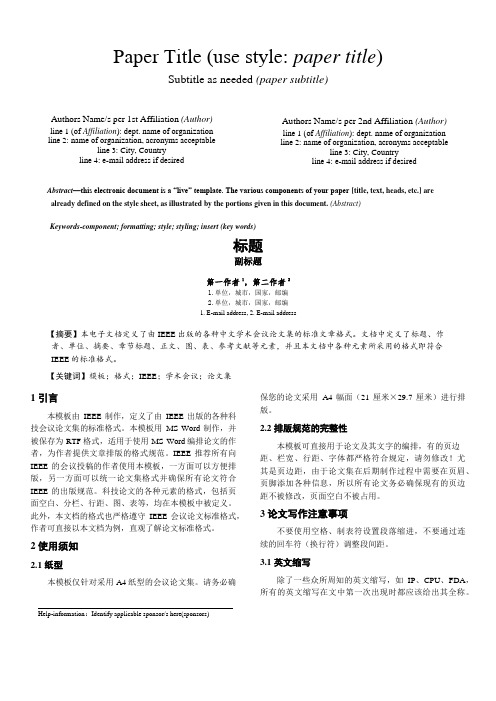
Paper Title (use style: paper title) Subtitle as needed (paper subtitle)Authors Name/s per 1st Affiliation (Author) line 1 (of Affiliation): dept. name of organization line 2: name of organization, acronyms acceptableline 3: City, Countryline 4: e-mail address if desired Authors Name/s per 2nd Affiliation (Author) line 1 (of Affiliation): dept. name of organization line 2: name of organization, acronyms acceptableline 3: City, Countryline 4: e-mail address if desiredAbstract—this electronic document is a “live” template. The various components of your paper [title, text, heads, etc.] are already defined on the style sheet, as illustrated by the portions given in this document. (Abstract)Keywords-component; formatting; style; styling; insert (key words)标题副标题第一作者1,第二作者21.单位,城市,国家,邮编2.单位,城市,国家,邮编1. E-mail address,2. E-mail address【摘要】本电子文档定义了由IEEE出版的各种中文学术会议论文集的标准文章格式。
journal of agricultural engineering投稿须知
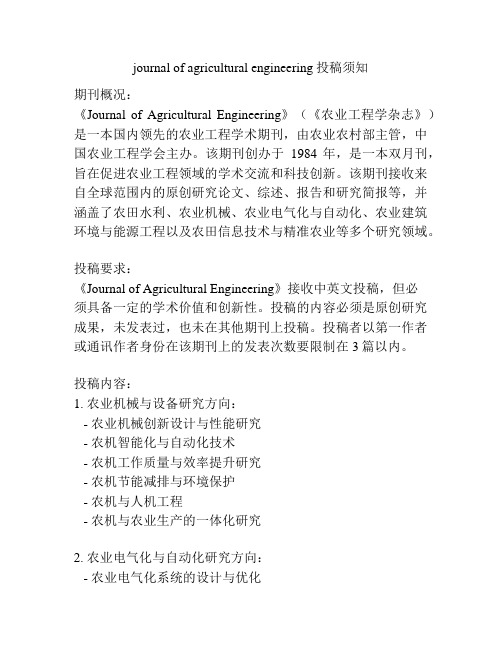
journal of agricultural engineering投稿须知期刊概况:《Journal of Agricultural Engineering》(《农业工程学杂志》)是一本国内领先的农业工程学术期刊,由农业农村部主管,中国农业工程学会主办。
该期刊创办于1984年,是一本双月刊,旨在促进农业工程领域的学术交流和科技创新。
该期刊接收来自全球范围内的原创研究论文、综述、报告和研究简报等,并涵盖了农田水利、农业机械、农业电气化与自动化、农业建筑环境与能源工程以及农田信息技术与精准农业等多个研究领域。
投稿要求:《Journal of Agricultural Engineering》接收中英文投稿,但必须具备一定的学术价值和创新性。
投稿的内容必须是原创研究成果,未发表过,也未在其他期刊上投稿。
投稿者以第一作者或通讯作者身份在该期刊上的发表次数要限制在3篇以内。
投稿内容:1. 农业机械与设备研究方向:- 农业机械创新设计与性能研究- 农机智能化与自动化技术- 农机工作质量与效率提升研究- 农机节能减排与环境保护- 农机与人机工程- 农机与农业生产的一体化研究2. 农业电气化与自动化研究方向:- 农业电气化系统的设计与优化- 农业自动控制技术与应用- 农业智能化监测与管理技术- 农业无人化作业技术研究- 农业电气化设备与材料研究3. 农业建筑环境与能源工程研究方向:- 农业建筑环境优化设计- 农业温室效应与节能措施- 农业空气、水、土壤质量调控技术研究 - 农业园艺植物生长与环境关系研究- 农业能源利用与清洁能源技术研究4. 农田水利研究方向:- 农田水资源调控与利用研究- 农田水管理与灌溉技术研究- 农田排水与水土保持研究- 农田水质与水环境保护研究- 农田水利工程与农业可持续发展研究5. 农田信息技术与精准农业研究方向:- 农田信息技术在农业生产中的应用研究 - 农业遥感与GIS技术在农田管理中的应用 - 农田作物信息获取与分析研究- 农业精准施肥与施药技术研究- 农田信息智能化决策与管理技术注意事项:1. 投稿的论文必须严格遵守学术伦理规范,未经授权不得涉及任何版权问题。
期刊carbon投稿须知
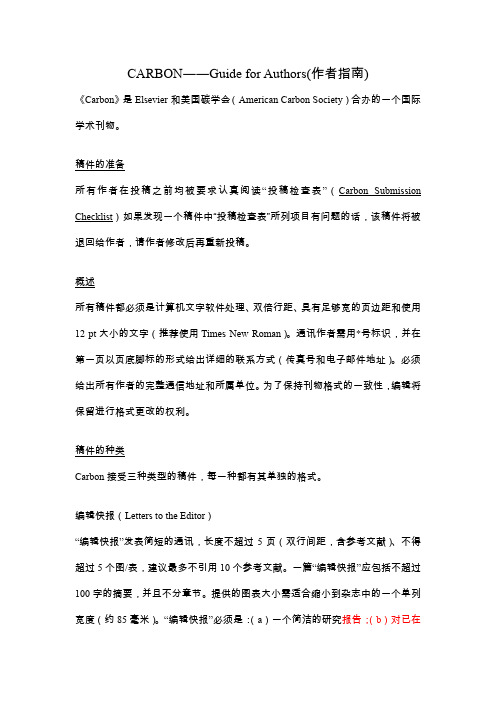
CARBON――Guide for Authors(作者指南) 《Carbon》是Elsevier和美国碳学会(American Carbon Society)合办的一个国际学术刊物。
稿件的准备所有作者在投稿之前均被要求认真阅读“投稿检查表”(Carbon Submission Checklist)如果发现一个稿件中“投稿检查表”所列项目有问题的话,该稿件将被退回给作者,请作者修改后再重新投稿。
概述所有稿件都必须是计算机文字软件处理、双倍行距、具有足够宽的页边距和使用12 pt大小的文字(推荐使用Times New Roman)。
通讯作者需用*号标识,并在第一页以页底脚标的形式给出详细的联系方式(传真号和电子邮件地址)。
必须给出所有作者的完整通信地址和所属单位。
为了保持刊物格式的一致性,编辑将保留进行格式更改的权利。
稿件的种类Carbon接受三种类型的稿件,每一种都有其单独的格式。
编辑快报(Letters to the Editor)“编辑快报”发表简短的通讯,长度不超过5页(双行间距,含参考文献)、不得超过5个图/表,建议最多不引用10个参考文献。
一篇“编辑快报”应包括不超过100字的摘要,并且不分章节。
提供的图表大小需适合缩小到杂志中的一个单列宽度(约85毫米)。
“编辑快报”必须是:(a)一个简洁的研究报告;(b)对已在Carbon上发表的其他论文进行评述。
研究论文(Research Papers)“研究论文”可以是任意长度的论文,应包括不超过200字的摘要,并分为用数字标明的如下所述的章节。
综合评述(Review Articles)“综合评述”一般由编辑邀请撰写,我们强烈建议你在投稿“综合评述”之前先与主编联系。
“综合评述”需就一个当前十分重要的研究主题或方向给予全面、系统、反映最新进展的评述,格式与“研究论文”相同,但需要在摘要之后立即给出一个目录。
请注意:所有论文都是即期发表,“编辑快报”并无优先权。
Elsevier投稿的一些问题
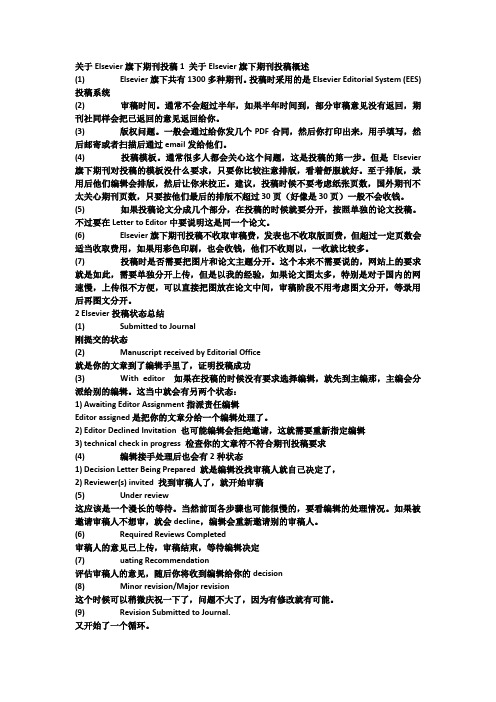
关于Elsevier旗下期刊投稿1 关于Elsevier旗下期刊投稿概述(1) Elsevier旗下共有1300多种期刊。
投稿时采用的是Elsevier Editorial System (EES)投稿系统(2) 审稿时间。
通常不会超过半年,如果半年时间到,部分审稿意见没有返回,期刊社同样会把已返回的意见返回给你。
(3) 版权问题。
一般会通过给你发几个PDF合同,然后你打印出来,用手填写,然后邮寄或者扫描后通过email发给他们。
(4) 投稿模板。
通常很多人都会关心这个问题,这是投稿的第一步。
但是Elsevier 旗下期刊对投稿的模板没什么要求,只要你比较注意排版,看着舒服就好。
至于排版,录用后他们编辑会排版,然后让你来校正。
建议,投稿时候不要考虑纸张页数,国外期刊不太关心期刊页数,只要按他们最后的排版不超过30页(好像是30页)一般不会收钱。
(5) 如果投稿论文分成几个部分,在投稿的时候就要分开,按照单独的论文投稿。
不过要在Letter to Editor中要说明这是同一个论文。
(6) Elsevier旗下期刊投稿不收取审稿费,发表也不收取版面费,但超过一定页数会适当收取费用,如果用彩色印刷,也会收钱,他们不收则以,一收就比较多。
(7) 投稿时是否需要把图片和论文主题分开。
这个本来不需要说的,网站上的要求就是如此,需要单独分开上传,但是以我的经验,如果论文图太多,特别是对于国内的网速慢,上传很不方便,可以直接把图放在论文中间,审稿阶段不用考虑图文分开,等录用后再图文分开。
2 Elsevier投稿状态总结(1) Submitted to Journal刚提交的状态(2) Manuscript received by Editorial Office就是你的文章到了编辑手里了,证明投稿成功(3) With editor如果在投稿的时候没有要求选择编辑,就先到主编那,主编会分派给别的编辑。
这当中就会有另两个状态:1) Awaiting Editor Assignment指派责任编辑Editor assigned是把你的文章分给一个编辑处理了。
中国药学杂志英文版杂志投稿须知

• ----摘要、关键词: 采用结构式摘要,即目的(Aim)、方法(Methods)、结果(Results)、 结论(Conclusion)。关键词不应少于3个,可从文题、摘要及正文中选取。尽量从《医学主 题词表(MeSH)》中选取规范的主题词。关键词之间用分号隔开,中英文要一致。
• ----正文: 层次分开,采用三级标题(一级标题黑体居中,二级标题黑体齐左,三级标题黑体 齐左空一格接排正文),应尽量减少层次。
次.出版地:出版社,年.起止页.
• [5] Peters W. Chemotherapy og malaria [A]. Kreier Jp.Malaria [M]. New York: Academic Press, 1980.xxx-xxx.
• 专利 专利所有者.专利题名 [P].专利国别:专利号,出版日期.
• ----表和图: 凡用文字可说明者尽量不用图表,既有图又有表,则去图留表,能合并者尽量合 并。表和图要设计合理,有自明性。表用三线表,栏目项不应有空缺,卧表方位顶左底右。 表内数字±对齐。表和图中的量、单位表示方式应是量符号在前,单位符号在后,其间加斜 线,如t/min。统计处理应写明所用的统计方法,显著性检验结果以*P<0.05,**P<0.01, ***P<0.001三档表示。图应去背景,照片要反差鲜明;显微镜照片内应画长度标尺,标示方 向。
• 投稿要求 • ----1. 来稿须附单位介绍信 (综述与述评除外),注明无一稿两投及
保密问题。论文若属基金资助,应标注于论文首页左下方,请写明资 助项目批准编号,同时附相关批准文件的复印件。
• ----2. 文章要求论点明确,数据可靠,结构严密,层次分明,文字 精炼。论文全文(包括中文摘要)一般不超过5千字,简报不超过3千 字。综述在8千字以内。论文请打印在A4纸上。
international journal of molecular sciences投稿须知
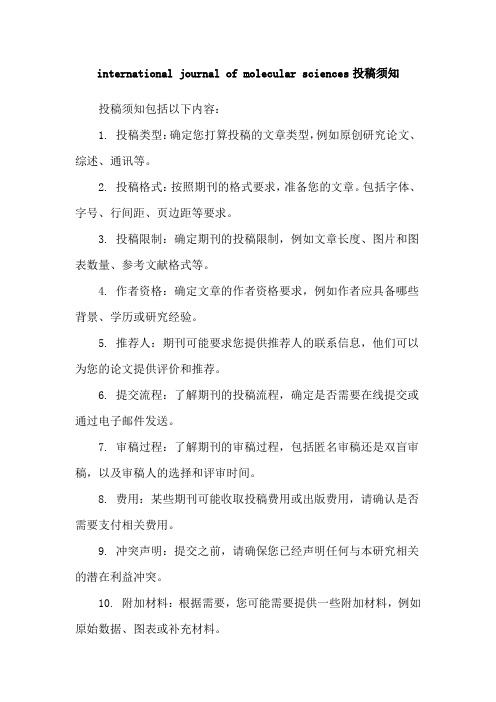
international journal of molecular sciences投稿须知
投稿须知包括以下内容:
1. 投稿类型:确定您打算投稿的文章类型,例如原创研究论文、综述、通讯等。
2. 投稿格式:按照期刊的格式要求,准备您的文章。
包括字体、字号、行间距、页边距等要求。
3. 投稿限制:确定期刊的投稿限制,例如文章长度、图片和图表数量、参考文献格式等。
4. 作者资格:确定文章的作者资格要求,例如作者应具备哪些背景、学历或研究经验。
5. 推荐人:期刊可能要求您提供推荐人的联系信息,他们可以为您的论文提供评价和推荐。
6. 提交流程:了解期刊的投稿流程,确定是否需要在线提交或通过电子邮件发送。
7. 审稿过程:了解期刊的审稿过程,包括匿名审稿还是双盲审稿,以及审稿人的选择和评审时间。
8. 费用:某些期刊可能收取投稿费用或出版费用,请确认是否需要支付相关费用。
9. 冲突声明:提交之前,请确保您已经声明任何与本研究相关的潜在利益冲突。
10. 附加材料:根据需要,您可能需要提供一些附加材料,例如原始数据、图表或补充材料。
请注意,以上内容仅供参考,具体投稿须知可能因期刊而异。
请在投稿之前仔细阅读并遵守期刊的投稿指南。
国外期刊投稿的注意事项
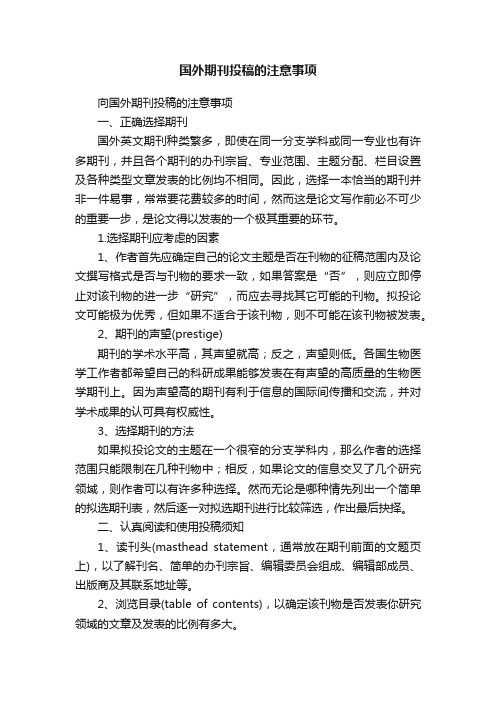
国外期刊投稿的注意事项向国外期刊投稿的注意事项一、正确选择期刊国外英文期刊种类繁多,即使在同一分支学科或同一专业也有许多期刊,并且各个期刊的办刊宗旨、专业范围、主题分配、栏目设置及各种类型文章发表的比例均不相同。
因此,选择一本恰当的期刊并非一件易事,常常要花费较多的时间,然而这是论文写作前必不可少的重要一步,是论文得以发表的一个极其重要的环节。
1.选择期刊应考虑的因素1、作者首先应确定自己的论文主题是否在刊物的征稿范围内及论文撰写格式是否与刊物的要求一致,如果答案是“否”,则应立即停止对该刊物的进一步“研究”,而应去寻找其它可能的刊物。
拟投论文可能极为优秀,但如果不适合于该刊物,则不可能在该刊物被发表。
2、期刊的声望(prestige)期刊的学术水平高,其声望就高;反之,声望则低。
各国生物医学工作者都希望自己的科研成果能够发表在有声望的高质量的生物医学期刊上。
因为声望高的期刊有利于信息的国际间传播和交流,并对学术成果的认可具有权威性。
3、选择期刊的方法如果拟投论文的主题在一个很窄的分支学科内,那么作者的选择范围只能限制在几种刊物中;相反,如果论文的信息交叉了几个研究领域,则作者可以有许多种选择。
然而无论是哪种情先列出一个简单的拟选期刊表,然后逐一对拟选期刊进行比较筛选,作出最后抉择。
二、认真阅读和使用投稿须知1、读刊头(masthead statement,通常放在期刊前面的文题页上),以了解刊名、简单的办刊宗旨、编辑委员会组成、编辑部成员、出版商及其联系地址等。
2、浏览目录(table of contents),以确定该刊物是否发表你研究领域的文章及发表的比例有多大。
3、注意栏目设置,确定拟投稿件的栏目。
4、看拟投栏目文章的范例,了解撰写要求及格式。
5、某些期刊刊登文章的投稿和接收日期(submitted and accepted dates),作者可据此计算出论文出版时滞(发表周期)。
6、注意广告数量,以间接判断期刊质量。
国外期刊投稿指南示例
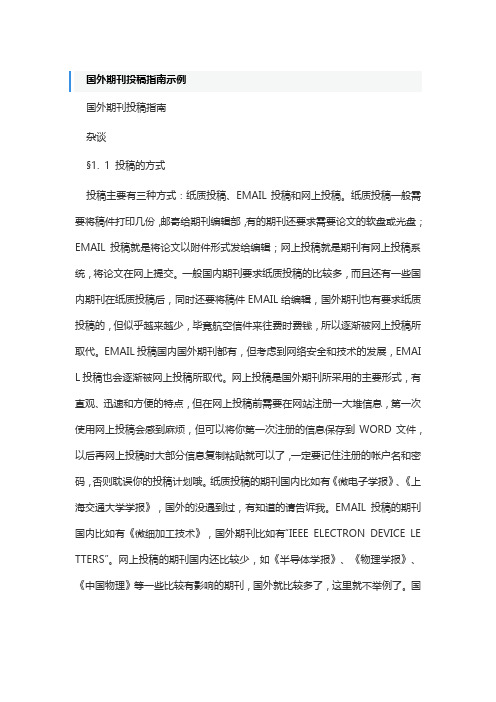
国外期刊投稿指南示例国外期刊投稿指南杂谈§1. 1 投稿的方式投稿主要有三种方式:纸质投稿、EMAIL投稿和网上投稿。
纸质投稿一般需要将稿件打印几份,邮寄给期刊编辑部,有的期刊还要求需要论文的软盘或光盘;EMAIL投稿就是将论文以附件形式发给编辑;网上投稿就是期刊有网上投稿系统,将论文在网上提交。
一般国内期刊要求纸质投稿的比较多,而且还有一些国内期刊在纸质投稿后,同时还要将稿件EMAIL给编辑,国外期刊也有要求纸质投稿的,但似乎越来越少,毕竟航空信件来往费时费钱,所以逐渐被网上投稿所取代。
EMAIL投稿国内国外期刊都有,但考虑到网络安全和技术的发展,EMAI L投稿也会逐渐被网上投稿所取代。
网上投稿是国外期刊所采用的主要形式,有直观、迅速和方便的特点,但在网上投稿前需要在网站注册一大堆信息,第一次使用网上投稿会感到麻烦,但可以将你第一次注册的信息保存到WORD文件,以后再网上投稿时大部分信息复制粘贴就可以了,一定要记住注册的帐户名和密码,否则耽误你的投稿计划哦。
纸质投稿的期刊国内比如有《微电子学报》、《上海交通大学学报》,国外的没遇到过,有知道的请告诉我。
EMAIL投稿的期刊国内比如有《微细加工技术》,国外期刊比如有“IEEE ELECTRON DEVICE LE TTERS”。
网上投稿的期刊国内还比较少,如《半导体学报》、《物理学报》、《中国物理》等一些比较有影响的期刊,国外就比较多了,这里就不举例了。
国内邮寄纸质文章用什么方式寄好呢?我以前用平信邮过的,没丢过,挂号和EM S当然安全迅速了,不在乎费用可以挂号和EMS的。
§1. 2 如何投稿有很多水友问自己该如何投稿,其实大概是这些水友第一次投稿吧?如何投稿主要从四个方面来着想:一是稿件内容和质量;二是找到适合的期刊;三是熟悉投稿要求和流程;四是经验的积累。
稿件的内容自然和你研究方向有关了,这个不能去强求改变,但与稿件质量相关联的似乎分为好几种,比如研究方向冷与热、实验结果成与败、文章表达优与劣、图形处理好与坏,当中有些我们还是可有作为的,这在以后如何写好论文中进行阐述。
elsevier期刊投稿须知
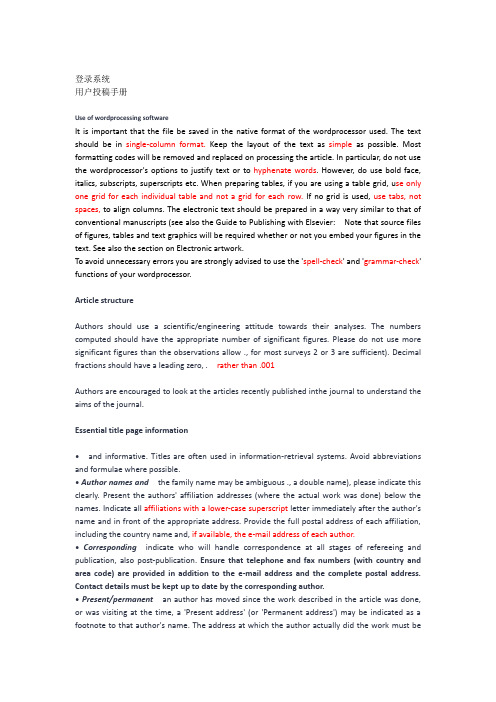
登录系统用户投稿手册Use of wordprocessing softwareIt is important that the file be saved in the native format of the wordprocessor used. The text should be in single-column format.Keep the layout of the text as simple as possible. Most formatting codes will be removed and replaced on processing the article. In particular, do not use the wordprocessor's options to justify text or to hyphenate words. However, do use bold face, italics, subscripts, superscripts etc. When preparing tables, if you are using a table grid, u se only one grid for each individual table and not a grid for each row. If no grid is used, use tabs, not spaces, to align columns. The electronic text should be prepared in a way very similar to that of conventional manuscripts (see also the Guide to Publishing with Elsevier: Note that source files of figures, tables and text graphics will be required whether or not you embed your figures in the text. See also the section on Electronic artwork.To avoid unnecessary errors you are strongly advised to use the 'spell-check' and 'grammar-check' functions of your wordprocessor.Article structureAuthors should use a scientific/engineering attitude towards their analyses. The numbers computed should have the appropriate number of significant figures. Please do not use more significant figures than the observations allow ., for most surveys 2 or 3 are sufficient). Decimal fractions should have a leading zero, .rather than .001Authors are encouraged to look at the articles recently published inthe journal to understand the aims of the journal.Essential title page information• and informative. Titles are often used in information-retrieval systems. Avoid abbreviations and formulae where possible.• Author names and the family name may be ambiguous ., a double name), please indicate this clearly. Present the authors' affiliation addresses (where the actual work was done) below the names. Indicate all affiliations with a lower-case superscript letter immediately after the author's name and in front of the appropriate address. Provide the full postal address of each affiliation, including the country name and, if available, the e-mail address of each author.• Corresponding indicate who will handle correspondence at all stages of refereeing and publication, also post-publication. Ensure that telephone and fax numbers (with country and area code) are provided in addition to the e-mail address and the complete postal address. Contact details must be kept up to date by the corresponding author.• Present/permanent an author has moved since the work described in the article was done, or was visiting at the time, a 'Present address' (or 'Permanent address') may be indicated as a footnote to that author's name. The address at which the author actually did the work must beretained as the main, affiliation address. Superscript Arabic numerals are used for such footnotes.AbstractA concise and factual abstract is required. The abstract should state briefly the purpose of the research, the principal results and major conclusions. An abstract is often presented separately from the article, so it must be able to stand alone. For this reason, References should be avoided, but if essential, then cite the author(s) and year(s). Also, non-standard or uncommon abbreviations should be avoided, but if essential they must be defined at their first mention in the abstract itself.The abstract should not be more than 100 words.KeywordsThe first page of the manuscript should also contain a short list of carefully chosen keywords or content indicators.AcknowledgementsCollate acknowledgements in a separate section at the end of the article before the references and do not, therefore, include them on the title page, as a footnote to the title or otherwise. List here those individuals who provided help during the research ., providing language help, writing assistance or proof reading the article, etc.).ArtworkElectronic artworkGeneral points• Make sure you use uniform lettering and sizing of your original artwork.字体和字号一致• Save text in illustrations as 'graphics' or enclose the font.• Only use the following fonts in your illustrations: Arial, Courier, Times, Symbol.插图字体• Number the illustration s according to their sequence in the text.插图安先后顺序排序• Use a logical naming convention for your artwork files.• Provide captions to illustrations separately.插图说明• Produce images near to the desired size of the printed version.• Submit each figure as a separate file.分别提交插图A detailed guide on electronic artwork is available on our website:You are urged to visit this site; some excerpts from the detailed information are given here. FormatsRegardless of the application used, when your electronic artwork is finalised, please 'save as' or convert the images to one of the following formats (note the resolution requirements for line drawings, halftones, and line/halftone combinations given below):EPS: Vector drawings. Embed the font or save the text as 'graphics'.TIFF: Color or grayscale photographs (halftones): always use a minimum of 300 dpi.TIFF: Bitmapped line drawings: use a minimum of 1000 dpi.TIFF: Combinations bitmapped line/half-tone (color or grayscale): a minimum of 500 dpi is required.If your electronic artwork is created in a Microsoft Office application (Word, PowerPoint, Excel) then please supply 'as is'.Please do not:• Supply files that are optimised for screen use ., GIF, BMP, PICT, WPG); the resolution is too low; • Supply files that are too low in resolution;• Submit graphics th at are disproportionately large for the content.Color artworkPlease make sure that artwork files are in an acceptable format (TIFF, EPS or MS Office files) and with the correct resolution. If, together with your accepted article, you submit usable color figures then Elsevier will ensure, at no additional charge, that these figures will appear in color on the Web ., ScienceDirect and other sites) regardless of whether or not these illustrations are reproduced in color in the printed version. For color reproduction in print, you will receive information regarding the costs from Elsevier after receipt of your accepted article.Please indicate your preference for color: in print or on the Web only. For further information on the preparation of electronic artwork, please seePlease note: Because of technical complications which can arise by converting color figures to 'gray scale' (for the printed version should you not opt for color in print) please submit in addition usable black and white versions of all the color illustrations.Figure captionsEnsure that each illustration has a caption. Supply captions separately, not attached to the figure.A caption should comprise a brief title (not on the figure itself) and a description of the illustration. Keep text in the illustrations themselves to a minimum but explain all symbols and abbreviations used.Text graphicsText graphics may be embedded in the text at the appropriate position. Further, high-resolution graphics files must be provided separately whether or not the graphics are embedded. See further under Electronic artwork.TablesNumber tables consecutively in accordance with their appearance in the text. Place footnotes totables below the table body and indicate them with superscript lowercase letters. Avoid vertical rules. Be sparing in the use of tables and ensure that the data presented in tables do not duplicate results described elsewhere in the article.ReferencesCitation in textPlease ensure that every reference cited in the text is also present in the reference list (and vice versa). Any references cited in the abstract must be given in full. Unpublished results and personal communications are not recommended in the reference list, but may be mentioned in the text. If these references are included in the reference list they should follow the standard reference style of the journal and should include a substitution of the publication date with either 'Unpublished results' or 'Personal communication'. Citation of a reference as 'in press' implies that the item has been accepted for publication.Citations to well known facts, statistical and psychological documents, mathematical techniques or articles more than eight years old should, in general, be avoided.Web referencesAs a minimum, the full URL should be given and the date when the reference was last accessed. Any further information, if known (DOI, author names, dates, reference to a source publication, etc.), should also be given. Web references can be listed separately ., after the reference list) under a different heading if desired, or can be included in the reference list.Please only refer to peer reviewed articles.References in a special issuePlease ensure that the words 'this issue' are added to any references in the list (and any citations in the text) to other articles in the same Special Issue.Reference management softwareThis journal has standard templates available in key reference management packages EndNote (and Reference Manager (support/. Using plug-ins to wordprocessing packages, authors only need to select the appropriate journal template when preparing their article and the list of references and citations to these will be formatted according to the journal style which is described below.Reference styleText: Indicate references by number(s) in square brackets in line with the text. The actual authors can be referred to, but the reference number(s) must always be given.Example: '..... as demonstrated [3,6]. Barnaby and Jones [8] obtained a different result ....'List: Number the references (numbers in square brackets) in the list in the order in which they appear in the text.Examples:Reference to a journal publication:[1] J. van der Geer, Hanraads, . Lupton, The art of writing a scientific article, J. Sci. Commun. 163 (2010) 51–59.Reference to a book:[2] W. Strunk Jr., . White, The Elements of Style, fourth ed., Longman, New York, 2000. Reference to a chapter in an edited book:[3] . Mettam, . Adams, How to prepare an electronic version of your article, in: . Jones, . Smith (Eds.), Introduction to the Electronic Age, E-Publishing Inc., New York, 2009, pp. 281–304.Journal abbreviations sourceJournal names should be abbreviated according toIndex Medicus journal abbreviations:List of title word abbreviations:CAS (Chemical Abstracts Service):Video dataElsevier accepts video material and animation sequences to support and enhance your scientific research. Authors who have video or animation files that they wish to submit with their article are strongly encouraged to include these within the body of the article. This can be done in the same way as a figure or table by referring to the video or animation content and noting in the body text where it should be placed. All submitted files should be properly labeled so that they directly relate to the video file's content. In order to ensure that your video or animation material is directly usable, please provide the files in one of our recommended file formats with a preferred maximum size of 50 MB. Video and animation files supplied will be published online in the electronic version of your article in Elsevier Web products, including ScienceDirect: Please supply 'stills' with your files: you can choose any frame from the video or animation or make a separate image. These will be used instead of standard icons and will personalize the link to your video data. For more detailed instructions please visit our video instruction pages at Note: since video and animation cannot be embedded in the print version of the journal, please provide text for both the electronic and the print version for the portions of the article that refer to this content.Supplementary dataElsevier accepts electronic supplementary material to support and enhance your scientific research. Supplementary files offer the author additional possibilities to publish supporting applications, high-resolution images, background datasets, sound clips and more. Supplementary files supplied will be published online alongside the electronic version of your article in Elsevier Web products, including ScienceDirect: In order to ensure that your submitted material is directly usable, please provide the data in one of our recommended file formats. Authors should submit the material in electronic format together with the article and supply a concise and descriptive caption for each file. For more detailed instructions please visit our artwork instruction pages atSubmission checklistThe following list will be useful during the final checking of an article prior to sending it to the journal for review. Please consult this Guide for Authors for further details of any item.Ensure that the following items are present:One author has been designated as the corresponding author with contact details:• E-mail address• Full postal address• Telephone and fax numbersAll necessary files have been uploaded, and contain:• Keywords• All figure captions• All tables (including title, description, footnotes)Further considerations• Manuscript has been 'spell-checked' and 'grammar-checked'• References are in the correct format for this journal• All references mentioned in the Reference list are cited in the text, and vice versa• Permission has been obtained for use of copyrighted material from other sources (including the Web)• Color figures are clearly marked as being intended for color reproduction on the Web (free of charge) and in print, or to be reproduced in color on the Web (free of charge) and in black-and-white in print• If only color on the Web is required, black-and-white versions of the figures are also supplied for printing purposesFor any further information please visit our customer support site at 陆系统投稿须知,包含内容:这三项内容需上传Covering Letter ,Highlights ,Manuscript ,Biographical NoteComments,reviewerInformation要求:1,摘要100字,实际272字;2,需要推荐两位评审;3,Comments内容;4,DSS是投Dss的,还是投I&M;我看DSS的作者有邓贵仕老师,而JOC里面的文章有Chuanren Liu。
Elsevier投稿的一些问题
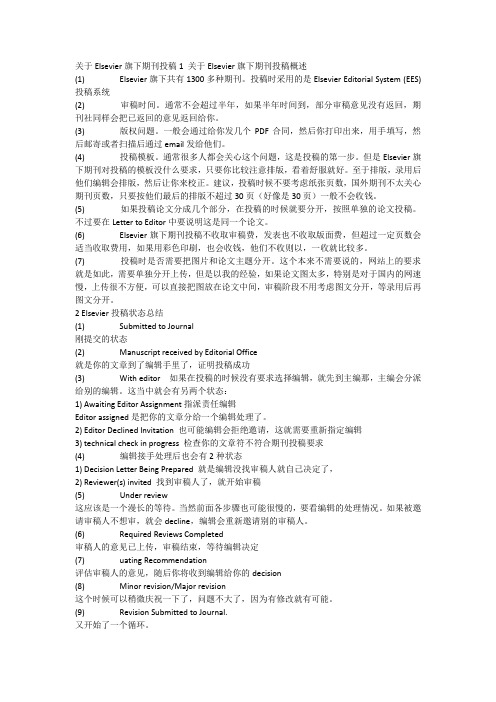
关于Elsevier旗下期刊投稿1 关于Elsevier旗下期刊投稿概述(1) Elsevier旗下共有1300多种期刊。
投稿时采用的是Elsevier Editorial System (EES)投稿系统(2) 审稿时间。
通常不会超过半年,如果半年时间到,部分审稿意见没有返回,期刊社同样会把已返回的意见返回给你。
(3) 版权问题。
一般会通过给你发几个PDF合同,然后你打印出来,用手填写,然后邮寄或者扫描后通过email发给他们。
(4) 投稿模板。
通常很多人都会关心这个问题,这是投稿的第一步。
但是Elsevier旗下期刊对投稿的模板没什么要求,只要你比较注意排版,看着舒服就好。
至于排版,录用后他们编辑会排版,然后让你来校正。
建议,投稿时候不要考虑纸张页数,国外期刊不太关心期刊页数,只要按他们最后的排版不超过30页(好像是30页)一般不会收钱。
(5) 如果投稿论文分成几个部分,在投稿的时候就要分开,按照单独的论文投稿。
不过要在Letter to Editor中要说明这是同一个论文。
(6) Elsevier旗下期刊投稿不收取审稿费,发表也不收取版面费,但超过一定页数会适当收取费用,如果用彩色印刷,也会收钱,他们不收则以,一收就比较多。
(7) 投稿时是否需要把图片和论文主题分开。
这个本来不需要说的,网站上的要求就是如此,需要单独分开上传,但是以我的经验,如果论文图太多,特别是对于国内的网速慢,上传很不方便,可以直接把图放在论文中间,审稿阶段不用考虑图文分开,等录用后再图文分开。
2 Elsevier投稿状态总结(1) Submitted to Journal刚提交的状态(2) Manuscript received by Editorial Office就是你的文章到了编辑手里了,证明投稿成功(3) With editor如果在投稿的时候没有要求选择编辑,就先到主编那,主编会分派给别的编辑。
这当中就会有另两个状态:1) Awaiting Editor Assignment指派责任编辑Editor assigned是把你的文章分给一个编辑处理了。
elsevier期刊投稿须知

/infman/登录系统/wps/find/journaldescription.cws_home/505553/authorinstructions用户投稿手册Use of wordprocessing softwareIt is important that the file be saved in the native format of the wordprocessor used. The text should be in single-column format.Keep the layout of the text as simple as possible. Most formatting codes will be removed and replaced on processing the article. In particular, do not use the wordprocessor's options to justify text or to hyphenate words. However, do use bold face, italics, subscripts, superscripts etc. When preparing tables, if you are using a table grid, u se only one grid for each individual table and not a grid for each row. If no grid is used, use tabs, not spaces, to align columns. The electronic text should be prepared in a way very similar to that of conventional manuscripts (see also the Guide to Publishing with Elsevier: /guidepublication). Note that source files of figures, tables and text graphics will be required whether or not you embed your figures in the text. See also the section on Electronic artwork.To avoid unnecessary errors you are strongly advised to use the 'spell-check' and 'grammar-check' functions of your wordprocessor.Article structureAuthors should use a scientific/engineering attitude towards their analyses. The numbers computed should have the appropriate number of significant figures. Please do not use more significant figures than the observations allow (i.e., for most surveys 2 or 3 are sufficient). Decimal fractions should have a leading zero, e.g. 0.001 rather than .001Authors are encouraged to look at the articles recently published inthe journal to understand the aims of the journal.Essential title page information• Title.Concise and informative. Titles are often used in information-retrieval systems. Avoid abbreviations and formulae where possible.• Author names and affiliations.Where the family name may be ambiguous (e.g., a double name), please indicate this clearly. Present the authors' affiliation addresses (where the actual work was done) below the names. Indicate all affiliations with a lower-case superscript letter immediately after the author's name and in front of the appropriate address. Provide the full postal address of each affiliation, including the country name and,if available, the e-mail address of each author.• Corresponding author.Clearly indicate who will handle correspondence at all stages of refereeing and publication, also post-publication. Ensure thattelephone and fax numbers (with country and area code) are provided in addition to the e-mail address and the complete postal address. Contact details must be kept up to date by the corresponding author.• Present/permanent address.If an author has moved since the work described in the article was done, or was visiting at the time, a 'Present address' (or 'Permanent address') may be indicated as a footnote to that author's name. The address at which the author actually did the work must be retained as the main, affiliation address. Superscript Arabic numerals are used for such footnotes.AbstractA concise and factual abstract is required. The abstract should state briefly the purpose of the research, the principal results and major conclusions. An abstract is often presented separately from the article, so it must be able to stand alone. For this reason, References should be avoided, but if essential, then cite the author(s) and year(s). Also, non-standard or uncommon abbreviations should be avoided, but if essential they must be defined at their first mention in the abstract itself.The abstract should not be more than 100 words.KeywordsThe first page of the manuscript should also contain a short list of carefully chosen keywords or content indicators.AcknowledgementsCollate acknowledgements in a separate section at the end of the article before the references and do not, therefore, include them on the title page, as a footnote to the title or otherwise. List here those individuals who provided help during the research (e.g., providing language help, writing assistance or proof reading the article, etc.).ArtworkElectronic artworkGeneral points• Make sure you use uniform lettering and sizing of your original artwork.字体和字号一致• Save text in illustrations as 'graphics' or enclose the font.• Only use th e following fonts in your illustrations: Arial, Courier, Times, Symbol.插图字体• Number the illustration s according to their sequence in the text.插图安先后顺序排序• Use a logical naming convention for your artwork files.• Provide captions to illustrations separately.插图说明• Produce images near to the desired size of the printed version.• Submit each figure as a separate file.分别提交插图A detailed guide on electronic artwork is available on our website:/artworkinstructionsYou are urged to visit this site; some excerpts from the detailed information are given here.FormatsRegardless of the application used, when your electronic artwork is finalised, please 'save as' or convert the images to one of the following formats (note the resolution requirements for line drawings, halftones, and line/halftone combinations given below):EPS: Vector drawings. Embed the font or save the text as 'graphics'.TIFF: Color or grayscale photographs (halftones): always use a minimum of 300 dpi.TIFF: Bitmapped line drawings: use a minimum of 1000 dpi.TIFF: Combinations bitmapped line/half-tone (color or grayscale): a minimum of 500 dpi is required.If your electronic artwork is created in a Microsoft Office application (Word, PowerPoint, Excel) then please supply 'as is'.Please do not:• Supply files that are optimised for screen use (e.g., GIF, BMP, PICT, WPG); the resolution is too low;• Supply files that a re too low in resolution;• Submit graphics that are disproportionately large for the content.Color artworkPlease make sure that artwork files are in an acceptable format (TIFF, EPS or MS Office files) and with the correct resolution. If, together with your accepted article, you submit usable color figures then Elsevier will ensure, at no additional charge, that these figures will appear in color on the Web (e.g., ScienceDirect and other sites) regardless of whether or not these illustrations are reproduced in color in the printed version. For color reproduction in print, you will receive information regarding the costs from Elsevier after receipt of your accepted article. Please indicate your preference for color: in print or on the Web only. For further information on the preparation of electronic artwork, please see /artworkinstructions.Please note: Because of technical complications which can arise by convertingcolor figures to 'gray scale' (for the printed version should you not opt for color in print) please submit in addition usable black and white versions of all the color illustrations.Figure captionsEnsure that each illustration has a caption. Supply captions separately, not attached to the figure. A caption should comprise a brief title (not on the figure itself) and a description of the illustration. Keep text in the illustrations themselves to a minimum but explain all symbols and abbreviations used.Text graphicsText graphics may be embedded in the text at the appropriate position. Further, high-resolution graphics files must be provided separately whether or not the graphics are embedded. See further under Electronic artwork.TablesNumber tables consecutively in accordance with their appearance in the text. Place footnotes to tables below the table body and indicate them with superscript lowercase letters. Avoid vertical rules. Be sparing in the use of tables and ensure that the data presented in tables do not duplicate results described elsewhere in the article.ReferencesCitation in textPlease ensure that every reference cited in the text is also present in the reference list (and vice versa). Any references cited in the abstract must be given in full. Unpublished results and personal communications are not recommended in the reference list, but may be mentioned in the text. If these references are included in the reference list they should follow the standard reference style of the journal and should include a substitution of the publication date with either 'Unpublished results' or 'Personal communication'. Citation of a reference as 'in press' implies that the item has been accepted for publication.Citations to well known facts, statistical and psychological documents, mathematical techniques or articles more than eight years old should, in general, be avoided.Web referencesAs a minimum, the full URL should be given and the date when the reference was last accessed. Any further information, if known (DOI, author names, dates, reference to a source publication, etc.), should also be given. Web references can be listed separately (e.g., after the reference list) under a different headingif desired, or can be included in the reference list.Please only refer to peer reviewed articles.References in a special issuePlease ensure that the words 'this issue' are added to any references in the list (and any citations in the text) to other articles in the same Special Issue. Reference management softwareThis journal has standard templates available in key reference management packages EndNote (/support/enstyles.asp) and Reference Manager (/support/rmstyles.asp). Using plug-ins to wordprocessing packages, authors only need to select the appropriate journal template when preparing their article and the list of references and citations to these will be formatted according to the journal style which is described below.Reference styleText: Indicate references by number(s) in square brackets in line with the text. The actual authors can be referred to, but the reference number(s) must always be given.Example: '..... as demonstrated [3,6]. Barnaby and Jones [8] obtained a different result ....'List: Number the references (numbers in square brackets) in the list in the order in which they appear in the text.Examples:Reference to a journal publication:[1] J. van der Geer, J.A.J. Hanraads, R.A. Lupton, The art of writing a scientific article, J. Sci. Commun. 163 (2010) 51–59.Reference to a book:[2] W. Strunk Jr., E.B. White, The Elements of Style, fourth ed., Longman, New York, 2000.Reference to a chapter in an edited book:[3] G.R. Mettam, L.B. Adams, How to prepare an electronic version of your article, in: B.S. Jones, R.Z. Smith (Eds.), Introduction to the Electronic Age, E-Publishing Inc., New York, 2009, pp. 281–304.Journal abbreviations sourceJournal names should be abbreviated according toIndex Medicus journal abbreviations:/tsd/serials/lji.html;List of title word abbreviations:/2-22661-LTWA-online.php;CAS (Chemical Abstracts Service): /sent.html.Video dataElsevier accepts video material and animation sequences to support and enhance your scientific research. Authors who have video or animation files that they wish to submit with their article are strongly encouraged to include these within the body of the article. This can be done in the same way as a figure or table by referring to the video or animation content and noting in the body text where it should be placed. All submitted files should be properly labeled so that they directly relate to the video file's content. In order to ensure that your video or animation material is directly usable, please provide the files in one of our recommended file formats with a preferred maximum size of 50 MB. Video and animation files supplied will be published online in the electronic version of your article in Elsevier Web products, including ScienceDirect: . Please supply 'stills' with your files: you can choose any frame from the video or animation or make a separate image. These will be used instead of standard icons and will personalize the link to your video data. For more detailed instructions please visit our video instruction pages at /artworkinstructions. Note: since video and animation cannot be embedded in the print version of the journal, please provide text for both the electronic and the print version for the portions of the article that refer to this content.Supplementary dataElsevier accepts electronic supplementary material to support and enhance your scientific research. Supplementary files offer the author additional possibilities to publish supporting applications, high-resolution images, background datasets, sound clips and more. Supplementary files supplied will be published online alongside the electronic version of your article in Elsevier Web products, including ScienceDirect: . In order to ensure that your submitted material is directly usable, please provide the data in one of our recommended file formats. Authors should submit the material in electronic format together with the article and supply a concise and descriptive caption for each file. For more detailed instructions please visit our artwork instruction pages at /artworkinstructions.Submission checklistThe following list will be useful during the final checking of an article prior to sending it to the journal for review. Please consult this Guide for Authors for further details of any item.Ensure that the following items are present:One author has been designated as the corresponding author with contactdetails:• E-mail address• Full postal address• Telephone and fax numbersAll necessary files have been uploaded, and contain:• Keywords• All figure captions• All tables (including title, description, footnotes)Further considerations• Manuscript has been 'spell-checked' and 'grammar-checked'• References are in the correct format for this journal• All references mentioned in the Reference list are cited in the text, and vice versa• Permission has been obtained f or use of copyrighted material from other sources (including the Web)• Color figures are clearly marked as being intended for color reproduction on the Web (free of charge) and in print, or to be reproduced in color on the Web (free of charge) and in black-and-white in print• If only color on the Web is required, black-and-white versions of the figures are also supplied for printing purposesFor any further information please visit our customer support site at ./locate/dss/decsup/default.asp?pg=login.asp陆系统/wps/find/journaldescription.cws_home/505540/authorinstructions#N1 0D2B投稿须知,包含内容:这三项内容需上传Covering Letter ,Highlights ,Manuscript ,Biographical NoteComments,reviewerInformation要求:1,摘要100字,实际272字;2,需要推荐两位评审;3,Comments内容;4,DSS20121007是投Dss的,还是投I&M;我看DSS20121007的作者有邓贵仕老师,而JOC20121007里面的文章有Chuanren Liu。
世界急诊医学杂志英文投稿须知

世界急诊医学杂志英文投稿须知
世界急诊医学杂志(The World Journal of Emergency Medicine)是一本专业的医学期刊,它接受英文投稿。
投稿者需要遵循一定的投稿须知,以确保稿件符合期刊的要求。
通常,投稿须知会涵盖以下内容:
1. 投稿类型,期刊可能接受原创研究论文、案例报告、综述文章等不同类型的稿件。
投稿者需要明确标明自己稿件的类型。
2. 格式要求,期刊会规定稿件的格式要求,包括字数限制、参考文献格式、图表要求等。
投稿者需要严格按照期刊的格式要求准备稿件。
3. 作者资格,投稿须知会说明作者资格的要求,例如是否需要具备医学背景、是否接受多位作者合作等。
4. 投稿方式,投稿须知会详细说明投稿的方式和流程,包括在线投稿系统的使用方法、联系方式等。
5. 审稿时间,期刊可能会说明审稿周期,以及投稿后的跟踪方
式。
6. 其他注意事项,投稿须知可能还包括其他注意事项,如伦理审查要求、作者声明等。
总之,投稿者需要仔细阅读并遵守世界急诊医学杂志的投稿须知,以确保稿件能够顺利被期刊接受并发表。
journal of ethnopharmacology投稿须知
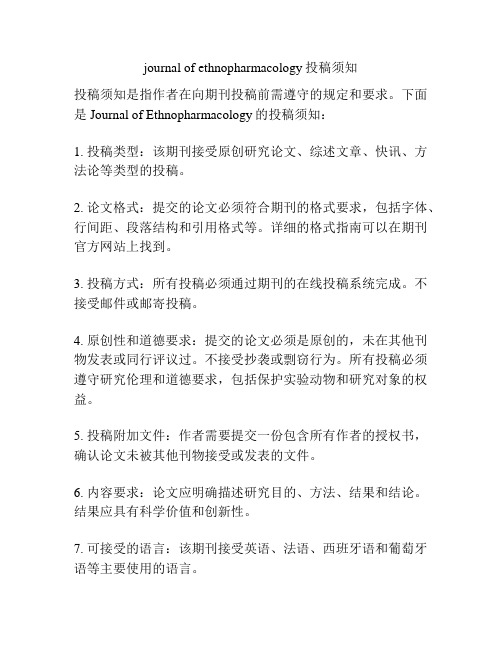
journal of ethnopharmacology投稿须知
投稿须知是指作者在向期刊投稿前需遵守的规定和要求。
下面是Journal of Ethnopharmacology的投稿须知:
1. 投稿类型:该期刊接受原创研究论文、综述文章、快讯、方法论等类型的投稿。
2. 论文格式:提交的论文必须符合期刊的格式要求,包括字体、行间距、段落结构和引用格式等。
详细的格式指南可以在期刊官方网站上找到。
3. 投稿方式:所有投稿必须通过期刊的在线投稿系统完成。
不接受邮件或邮寄投稿。
4. 原创性和道德要求:提交的论文必须是原创的,未在其他刊物发表或同行评议过。
不接受抄袭或剽窃行为。
所有投稿必须遵守研究伦理和道德要求,包括保护实验动物和研究对象的权益。
5. 投稿附加文件:作者需要提交一份包含所有作者的授权书,确认论文未被其他刊物接受或发表的文件。
6. 内容要求:论文应明确描述研究目的、方法、结果和结论。
结果应具有科学价值和创新性。
7. 可接受的语言:该期刊接受英语、法语、西班牙语和葡萄牙语等主要使用的语言。
8. 费用:该期刊对于接受的论文会收取出版费用。
以上是Journal of Ethnopharmacology的一般投稿须知,具体的要求可能会因期刊政策的变化而有所调整,请在投稿前仔细阅读期刊的官方网站上的最新投稿须知。
外文期刊发表注意事项
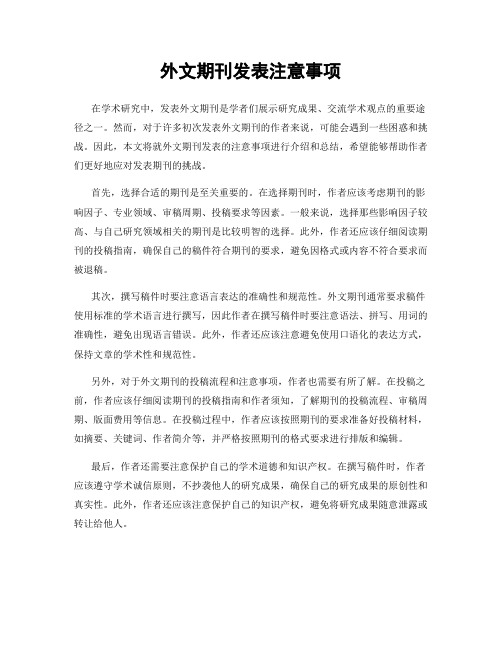
外文期刊发表注意事项在学术研究中,发表外文期刊是学者们展示研究成果、交流学术观点的重要途径之一。
然而,对于许多初次发表外文期刊的作者来说,可能会遇到一些困惑和挑战。
因此,本文将就外文期刊发表的注意事项进行介绍和总结,希望能够帮助作者们更好地应对发表期刊的挑战。
首先,选择合适的期刊是至关重要的。
在选择期刊时,作者应该考虑期刊的影响因子、专业领域、审稿周期、投稿要求等因素。
一般来说,选择那些影响因子较高、与自己研究领域相关的期刊是比较明智的选择。
此外,作者还应该仔细阅读期刊的投稿指南,确保自己的稿件符合期刊的要求,避免因格式或内容不符合要求而被退稿。
其次,撰写稿件时要注意语言表达的准确性和规范性。
外文期刊通常要求稿件使用标准的学术语言进行撰写,因此作者在撰写稿件时要注意语法、拼写、用词的准确性,避免出现语言错误。
此外,作者还应该注意避免使用口语化的表达方式,保持文章的学术性和规范性。
另外,对于外文期刊的投稿流程和注意事项,作者也需要有所了解。
在投稿之前,作者应该仔细阅读期刊的投稿指南和作者须知,了解期刊的投稿流程、审稿周期、版面费用等信息。
在投稿过程中,作者应该按照期刊的要求准备好投稿材料,如摘要、关键词、作者简介等,并严格按照期刊的格式要求进行排版和编辑。
最后,作者还需要注意保护自己的学术道德和知识产权。
在撰写稿件时,作者应该遵守学术诚信原则,不抄袭他人的研究成果,确保自己的研究成果的原创性和真实性。
此外,作者还应该注意保护自己的知识产权,避免将研究成果随意泄露或转让给他人。
总之,发表外文期刊是一项需要认真对待的学术活动,作者需要在选择期刊、撰写稿件、投稿流程、学术道德等方面都要做到严谨和规范。
希望本文介绍的注意事项能够帮助作者们更好地应对外文期刊发表的挑战,顺利发表自己的研究成果。
JAMA美国医学会杂志投稿须知
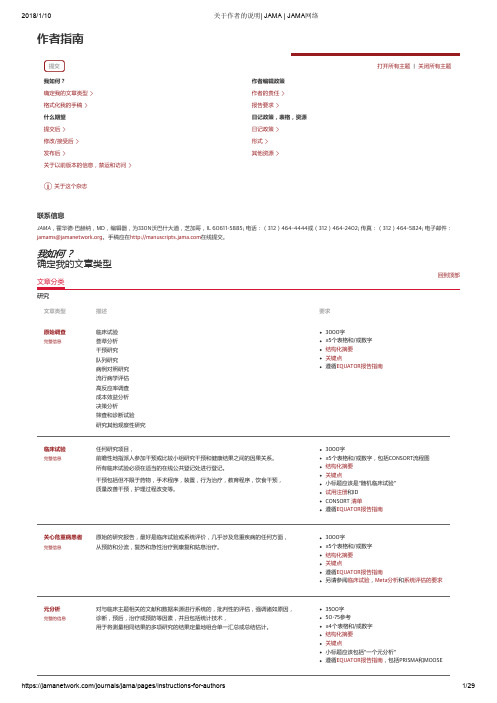
我如何?
文章分类
研究
文章类型 原始调查
完整信息
确定我的文章类型
回到顶部
描述 临床试验 荟萃分析 干预研究 队列研究 病例对照研究 流行病学评估 高反应率调查 成本效益分析 决策分析 筛查和诊断试验 研究其他观察性研究
要求 3000字 ≤5个表格和/或数字 结构化摘要 关键点 遵循EQUATOR报告指南
临床挑战
完整信息
介绍一个具有特定疾病或状况的实际患者病例以及伴随的临床图像。 特点“你会接下来做什么?”
“你接下来会做什么?” 有4个可能的治疗方案可供选择,其中1个是首选 案例介绍:250字 讨论:500 600字 ≤10个参考 ≤3名作者 1 2个小数字 可能需要患者许可
诊断测试解释
完整的信息
这篇文章需要一个预先提交调查。 介绍一个病人的诊断测试结果,并探索测试结果的临床应用; 旨在帮助临床医生了解订购测试的基本原理,解释测试结果, 并根据诊断测试结果采取行动。
要求 ≤1400字 ≤3名作者 ≤3幅图片(图) 可能需要图像的第三方权限
我的心灵的一块
充分的信息
从广泛的医学经验中获得的个人小插图(例如,探索病人与医生关系的动态) 偶尔会对影响这个行业的无数问题发表意见和看法。
≤1600字 ≤3名作者 可能需要患者许可
诗歌
充分的信息
如何向外文期刊投稿
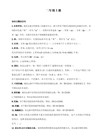
1 了解认识专业期刊
高水平的专业期刊一般通过所刊登的论文反映其所涉及专业的最新进展、前言动态,与科技的最新发展保持同步,既论文代表着其刊物的质量和地位。因此,投稿前十分有必要了解刊物的水平、方针、宗旨。
2 选择投稿的期刊
有经验的作者都知道先选择要投稿的期刊,而后撰写论文,既先研究市场,再研制产品。
5.了解同行评审对稿件的要求
同行评审是国外高水平期刊对来稿评审普遍采取的方式。需要指出的是:专家的意见不一定都正确,如果作者与他们的意见不一致,可以进行解释或辩解,不要轻易顺从或放弃。同行评审的主要目的是对稿件的质量进行控制,确保提交的论文是可读的、可信的和有意义的。这正是为什么一般都认为现刊载文经过同行评审其学术水平高于会议文献等其他文献类型的原因所在。
2.提高论文质量,争取在源期刊上发表
如前所述,《SCI》的关键部分是引文索引和来源索引。如果你的论文被《SCI》源期刊论文引用出现在源期刊论文的参考文献中,那么,你的论文就有可能被《SCI》的引文索引收录;如பைடு நூலகம்你的论文能在其源期刊上发表,那么你的论文就有可能被它的来源索引收录。
从的两个技术指标可以看出,编辑是很重视论文或期刊的质量的,如果论文的学术水平高,就有可能被《SCI》源期刊论文引用或在《SCI》源期刊上发表,需提醒广大科研人员注意的是,如果你的论文学术水平很高,你可把论文投向影响因子或即时指数较高的源期刊上,如美国《科学》周刊等,这样你的论文被同行引用的次数就会多,被《SCI》收录的机会也会更多。
3 认真阅读“投稿须知”
选择好投稿的刊物后,要认真阅读“投稿须知”,他是了解某一刊物的最重要的信息,所有的编辑都一再强调这一点;而且,这一步骤一定要在撰写论文之前进行。“投稿须知”一般在刊物的封里、封底或刊物的网址上。需要从中了解的内容主要有:刊物的宗旨、刊物稿件的专业范围、刊物的读者、编辑方针、稿件的接收标准、文稿的格式要求、稿件的长度、稿件的语言、参考文献、注释、插图/图表、正文是否需要隔行打印(给编辑留出修改的地方)。如果作者的文稿被一个刊物退稿,打算改投另一个刊物,也需要根据哪个刊物的“投稿须知”修改后寄出。
发表SCI或EI类英文文章的一些投稿经验
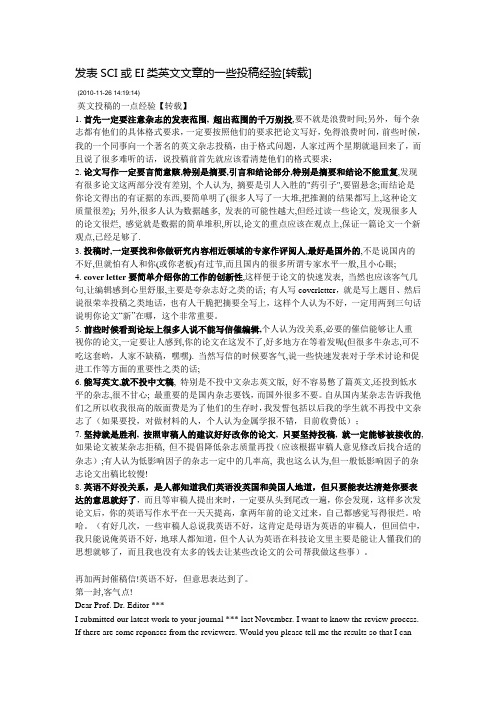
发表SCI或EI类英文文章的一些投稿经验[转载](2010-11-26 14:19:14)英文投稿的一点经验【转载】1. 首先一定要注意杂志的发表范围, 超出范围的千万别投,要不就是浪费时间;另外,每个杂志都有他们的具体格式要求,一定要按照他们的要求把论文写好,免得浪费时间,前些时候,我的一个同事向一个著名的英文杂志投稿,由于格式问题,人家过两个星期就退回来了,而且说了很多难听的话,说投稿前首先就应该看清楚他们的格式要求;2. 论文写作一定要言简意赅,特别是摘要,引言和结论部分,特别是摘要和结论不能重复,发现有很多论文这两部分没有差别, 个人认为, 摘要是引人入胜的"药引子",要留悬念;而结论是你论文得出的有证据的东西,要简单明了(很多人写了一大堆,把推测的结果都写上,这种论文质量很差); 另外,很多人认为数据越多, 发表的可能性越大,但经过读一些论文, 发现很多人的论文很烂, 感觉就是数据的简单堆积,所以,论文的重点应该在观点上,保证一篇论文一个新观点,已经足够了.3. 投稿时,一定要找和你做研究内容相近领域的专家作评阅人,最好是国外的,不是说国内的不好,但就怕有人和你(或你老板)有过节,而且国内的很多所谓专家水平一般,且小心眼;4. cover letter要简单介绍你的工作的创新性,这样便于论文的快速发表, 当然也应该客气几句,让编辑感到心里舒服,主要是夸杂志好之类的话; 有人写coverletter,就是写上题目、然后说很荣幸投稿之类地话,也有人干脆把摘要全写上,这样个人认为不好,一定用两到三句话说明你论文“新”在哪,这个非常重要。
5. 前些时候看到论坛上很多人说不能写信催编辑,个人认为没关系,必要的催信能够让人重视你的论文,一定要让人感到,你的论文在这发不了,好多地方在等着发呢(但很多牛杂志,可不吃这套哟,人家不缺稿,嘿嘿). 当然写信的时候要客气,说一些快速发表对于学术讨论和促进工作等方面的重要性之类的话;6. 能写英文,就不投中文稿, 特别是不投中文杂志英文版, 好不容易憋了篇英文,还投到低水平的杂志,很不甘心; 最重要的是国内杂志要钱,而国外很多不要。
- 1、下载文档前请自行甄别文档内容的完整性,平台不提供额外的编辑、内容补充、找答案等附加服务。
- 2、"仅部分预览"的文档,不可在线预览部分如存在完整性等问题,可反馈申请退款(可完整预览的文档不适用该条件!)。
- 3、如文档侵犯您的权益,请联系客服反馈,我们会尽快为您处理(人工客服工作时间:9:00-18:30)。
如何向国外投稿
当我们撰写好一篇学术论文后,接着要做的工作就是投稿,下面我们简要介绍一下如何向国外期刊投稿和注意事项。
投稿
一般来说,投稿程序分以下三步进行:
1 准备投稿信(covering letter ,submission letter )
科技期刊的编辑往往需要一些有关作者和作者论文的信息,而作者也希望给编辑提供一些有助于其全文送审及决策的信息。
这些信息都应该包括在投稿信中。
投稿信应包括以下几方面的内容:
文章题名和所有作者的姓名;
稿件适宜的栏目;
为什么此论文适合于在该刊而不是其它刊物上发表?关于重复或部分发表或已投它刊的说明;
转让版权的说明;
建议审稿人及因存在竞争关系而不宜做审稿人的名单;
通信作者(corresponding author )的姓名、详细地址、电话和传真号码、e-mail 地址;
是否愿意付出版费(版面费、彩图费)的说明(如果该刊收取版面费和彩图费);
希望该校样或稿件若不接收,退回原稿的要求
(有的期刊在“投稿须知”中约定,除非作者在投稿信中提出要求,否则原稿不退还给作者)
投稿信举例:
Dear Dr .:
Enclosed are three copies of a manuscript by Rose N .Dipaola ,Donna
A .Gallo ,and Tom N .Roberts titled “ Hepatitis C Virus Infection in Long-Term Transfusion Patients ”.It is submitted to be considered for publication as a “ Original Article" in your journal .This paper is neither the entire paper nor any part of its content has been published or has been accepted elsewhere .It is not being submitted to any other journal .
We believe the paper may be of particular interest to the readers of your journal because the study it reports stated the HCV infection rate among long-term transfusion patients is higher than that of the general population and of short-term transfusion patients .
Correspondence and phone calls about the paper should be directed to Ros e
N .Dipaola at the following address ,phone and fax number ,and e-mail address :
Rose N .Dipaola ,MD
Institute of Internal Medicine
Cleveland Clinic Foundation
9500 Euclid Ave .
Cleveland ,OH44195 ,USA
Tel :1-216-444-5360
Fax :1-216-444-9580
E-mail :dipao@cesmtp .ccf. Org
Thanks very much for your attention to our paper .
Sincerely yours ,
Rose N .Dipaola
2 稿件包装
所谓稿件包装是指将稿件及其拟投期刊所需的伴随资料一并装入信封。
一般应按以下顺序备齐资料:
投稿信;
刊物要求的稿件(包括文题页、文摘页、正文、致谢、参考文献、图注、表及图)拷贝份数,每份图单独装一个信封;
版权转让声明
与稿件内容有关资料的拷贝(如学术会议报告论文或已发表的摘要等材料);
通知稿件收到的明信片或有作者地址并贴足邮资的信封(适用于不发收稿回执的期刊);
致谢
有些期刊要求附稿件对照检查表;
以上材料不要用订书钉固定,以免途中因订书钉移动而损坏稿件;但可以用大型曲别针固定,照片可以在信封中夹硬纸片保护
3 稿件邮寄
邮寄稿件应注意:
应至少自留一份打印底稿;
信封要足够大,并足够结实;
正确的投稿地址及收稿人(“投稿须知”中常有说明,多要求直接寄给主编);
照片不可过大,最大不超过8.5 英寸x11 英寸?贴足邮票;
航空邮寄;
?以打印稿(hard copy )投稿一般国外的科技期刊不接受传真(fax) 投稿,某些期刊仅允许一些没有图表的短文或“给编辑的信”通过电子邮件(e-mail )投稿,长篇论著、研究报告等文章决定刊用后方接受光盘。
以上信息可以从“投稿须知”中获得、有的期刊在“投稿须知”中特别指出投稿地址与订刊或订单行本的地址不一样,作者应特别注意,以免造成不必要的时间耽搁。
投稿后若干事宜
稿件追踪(follow-up correspondence) .如果投稿 2 周仍无任何有关稿件收到的信息,也可打电话、发 e -mail 或写信给编辑部核实稿件是否收到。
稿件退修(revised manuscript) 几乎所有的经审查学术水平达到出版要求的自由来稿,在发表前都需要退给作者修改其表述及编辑格式,如压缩文章篇幅、重新设计表
格、改善插图质量、限制不规则缩写词使用等。
然而退给作者修改的稿件并不代表文章已经被接受,文章最终接受与否取决于作者对文章关键性重要内容和表述方式的修改能否达到审稿专家及编辑的要求。
通常退给作者修改的材料包括原稿、审稿专家意见、(reviewers' comments )和一封编辑的信(covering letter )。
当作者收倒退修稿后,首先应该仔细地阅读退修信(modify letter )和审稿专家意见。
然后应考虑能否或愿意接受审稿专家或编辑的意见,修改稿件。
